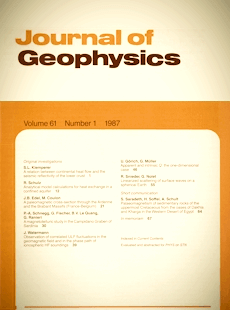Two-dimensional modelling of a towed transient magnetic dipole-dipole sea floor EM system
Article Sidebar

Vols. 1-18 (1924-1944), ISSN 0044-2801
Main Article Content
Abstract
The discovery of massive sulphide deposits along mid-ocean ridges has prompted the development of towed sea floor electromagnetic mapping tools. One suitable configuration of transmitter and receiver is the in-line, coaxial, magnetic dipole-dipole. The step response of this system to a double half-space model has two distinct parts. The position in time of the initial event is indicative of the conductivity of the sea floor. A reduction in dimensionality greatly simplifies the analytic and numerical computation of more complicated cases. The transmitter is reduced to a pair of horizontal line sources carrying equal but opposite currents and separated by a small vertical distance. The transient responses of the simplified system and the coaxial system to the double half-space model are remarkably similar, even though the electromagnetic mode characterised by vertical current flow is excluded by the simplification. The analytic form of the sensitivity function enables a simple expression for a depth of investigation beneath the sea floor to be derived as a function of time. The magnetic effects of currents impressed in a two-dimensional conductive target embedded in the sea floor by a horizontal magnetic point dipole transmitter may be represented approximately by a system of vortex currents only. Since vortex current flow is the type of current flow induced in a two-dimensional target by a two-dimensional magnetic source, the principal characteristics of the three-dimensional problem can be studied by two-dimensional modelling. The scattered fields from a thin conductive dike and a thin conductive sill are evaluated by setting up and solving a boundary element integral equation in the electric field. Transient response curves are presented for a limited range of models. The sea floor conductivity is fixed at 1/30 that of seawater, a typical value for recent basalt. The array size and plate depth extent are fixed at 100 m and 25 m, respectively, while the depth of burial is allowed to vary from 4 m to 25 m. The ratio of the inductive response parameter of the plate to the response parameter of the crust, which determines the degree of influence of the plate conductor on the combined step response, is varied from 0.4 to 10. Increasing the relative effect of the target delays the onset and decreases the gradient of the initial part of the response. Pronounced minima in the response as a function of array location are observed when either the transmitter or the receiver cross over the target. The minimum field over a wide range of times is close to zero for a shallow dike due to the combined shielding effect of the dike and the seawater. The shallow dike may be distinguished from a shallow sill by the shape of the minima.
 ARK: https://n2t.net/ark:/88439/y079019
ARK: https://n2t.net/ark:/88439/y079019
Permalink: https://geophysicsjournal.com/article/123
Article Details
References
Chave, A.D. (1983) Numerical integration of related Hankel transforms by quadrature and continued fraction expansion. Geophysics 48:1671-1686
Chave, A.D. (1984) The Frechet derivatives of electromagnetic induction. J. Geophys. Res. 89:3373-3380
Cheesman, S.J., Edwards, R.N., Chave, A.D. (1987) On the theory of sea floor conductivity mapping using transient EM systems. Geophysics 52:204-217
Davis, B., Martin, B. (1979) Numerical inversion of the Laplace transform: a survey and comparison of methods. J. Comp. Phys. 33:1-32
Edwards, R.N., Chave, A.D. (1986) On the theory of a transient electric dipole-dipole method for mapping the conductivity of the sea floor. Geophysics 51:984-987
Erdelyi, A., Magnus, W., Oberhettinger, F.G., Tricomi, F.G. (1954) Tables of integral transforms 1. McGraw-Hill, New York
Francheteau, J.H., Needham, H.D., Choukroune, P., Juteau, T., Seguret, M., Ballard, R.D., Fox, P.J., Normark, W., Carranza, A., Cordoba, D., Guerrero, J., Rangin, C., Bougault, H., Cambon, P., Hekinian, R. (1979) Massive deep-sea sulphide ore deposits discovered on the East Pacific Rise. Nature 277:523-528
Fullagar, P.K., Oldenburg, D.W. (1984) Inversion of horizontal loop electromagnetic frequency soundings. Geophysics 49:150-164
Hekinian, R., Fevrier, M., Bischoff, J.C., Picot, P., Shanks, W.C. (1980) Sulfur deposits from the East Pacific Rise near 21° N. Science 207:1433-1444
Inan, A.S., Fraser-Smith, A.C., Villard, Jr., O.G. (1986) ULF/ELF electromagnetic fields generated along the sea floor interface by a straight current source of infinite length. Radio Sci. 21:409-420
Knight, J.H., Raiche, A.P. (1982) Transient electromagnetic calculations using the Gaver-Stehfest algorithm. Geophysics 47:47-50
Koski, R.A., Normark, W.R., Morton, J.L. (1985) Massive sulfide deposits on the southern Juan de Fuca ridge: results of investigations in the USGS study area, 980-83. Marine Mining 5:147-164
Luke, Y.L. (1962) Integrals of Bessel functions. McGraw-Hill Book Co., New York
MalahofT, A. (1982) A comparison of the massive submarine polymetallic sulfides of the Galapagos Rift with some continental deposits. Marine Tech. Soc. J. 16:39-45
Normark, W.R., Morton, J.C., Koski, R.A., Clague, D.A., Delaney, J.R. (1983) Active hydrothermal vents and sulfide deposits on the southern Juan de Fuca ridge. Geology 11:158-163
Parker, R.L. (1977) The Frechet derivative for the one-dimensional electromagnetic induction problem. Geophys. J.R. Astron. Soc. 49:543-547
Rona, P.A. (1985) Hydrothermal mineralization at slow-spreading centers: Red Sea, Atlantic Ocean, and Indian Ocean. Marine Mining 5:117-146
Stehfest, H. (1970) Algorithm 368, numerical inversion of Laplace transforms. Commun. ACM 13:47-49
Tivey, M.K., Delaney, J.R. (1985) Sulfide deposits from the Endeavour segment of the Juan de Fuca ridge. Marine Mining 6:165-180
Wait, J. R. (1953) The fields of a line source of current over a stratified conductor. Appl. Sci. Res. 83:279-292
Wait, J.R. (1962) Theory of magnetotelluric fields. J. Res. NBS. Rad. Prop., 66D 5:509-541
Wolfgram, P.A., Edwards, R.N., Law, L.K., Bone, M.N. (1986) Polymetallic sulfide exploration on the deep sea floor: the feasibility of the Mini-Moses technique. Geophysics 51:1808-1818











